
Gustav Theodor Fechner was a German physicist, philosopher, and experimental psychologist. A pioneer in experimental psychology and founder of psychophysics, he inspired many 20th-century scientists and philosophers. He is also credited with demonstrating the non-linear relationship between psychological sensation and the physical intensity of a stimulus via the formula: , which became known as the Weber–Fechner law.

Anostostomatidae is a family of insects in the order Orthoptera, widely distributed in the southern hemisphere. It is named Mimnermidae or Henicidae in some taxonomies, and common names include king crickets in Australia and South Africa, and wētā in New Zealand. Prominent members include the Parktown prawn of South Africa, and the giant wētā of New Zealand.
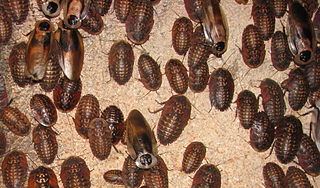
Giant cockroaches, or blaberids, are the second-largest cockroach family by number of species. Mostly distributed in warmer climates worldwide, this family is based on the American genus Blaberus, but much of the diversity is also found in Africa and Asia.

Parcoblatta virginica, the Virginia wood cockroach, is a small cockroach species of the genus Parcoblatta, measuring about a centimeter long as an adult.

Cockroaches are insects belonging to the order Blattodea (Blattaria). About 30 cockroach species out of 4,600 are associated with human habitats. Some species are well-known pests.

The giant burrowing cockroach is also known as the rhinoceros cockroach, and Queensland giant cockroach. These cockroaches are native to Australia and mostly found in tropical and subtropical parts of Queensland. They are the world's heaviest species of cockroach and can weigh up to 30-35 grams and measure up to 7.5-8 cm (3.1 in) in length. It is a member of the family Blaberidae, which contains hundreds of species. It is part of the blaberid subfamily Geoscapheinae. It is prominent in the wild and can also be sold and kept as a pet.
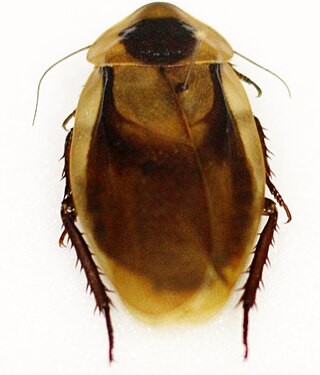
Blaberus discoidalis, commonly known as the discoid cockroach, tropical cockroach, West Indian leaf cockroach, false death's head cockroach, Haitian cockroach, and drummer, is a cockroach native to Central America of the "giant cockroach" family, Blaberidae.
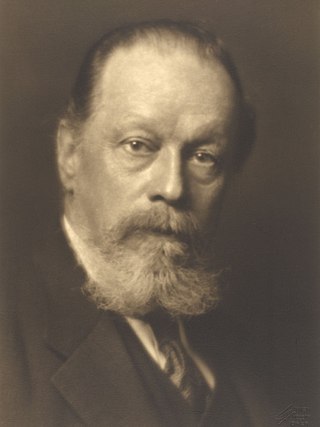
Richard Wettstein was an Austrian botanist. His taxonomic system, the Wettstein system, was one of the earliest based on phyletic principles.

Blatta is a genus of cockroaches. The name Blatta represents a specialised use of Latin blatta, meaning a light-shunning insect.

Blaptica dubia, the dubia roach, orange-spotted roach, Guyana spotted roach, or Argentinian wood roach, is a medium-sized species of cockroach which grows to around 40–45 mm (1.6–1.8 in).

Parcoblatta divisa, the southern wood cockroach, is a species of cockroach native to the United States.

Parcoblatta lata, the broad wood cockroach, is a species of wood cockroach native to the United States. It is one of the largest species of wood cockroaches.
Griffiniella heterogamia is a species of cockroach described by Heinrich Hugo Karny in 1908. Its known distribution is limited to the neighboring countries of Namibia and Botswana.

Agraeciini is a large tribe of bush crickets or katydids in the conehead subfamily, Conocephalinae.
Lipotactes is a genus of bush crickets found in southern China, Indo-China and Malesia; it is the only living genus in the subfamily Lipotactinae.
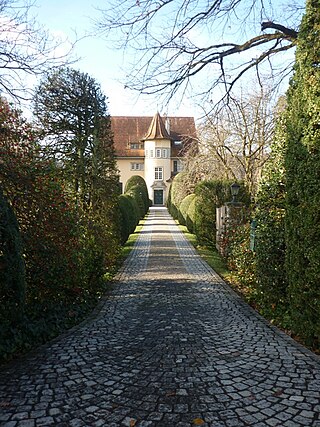
The C. G. Jung House Museum is a historic house museum. It was the residence of the Swiss psychiatrist, psychologist, and essayist Carl Jung as well as his wife, psychologist Emma Jung-Rauschenbach. It is located at Seestrasse 228, Küsnacht, Switzerland, next to Lake Zürich.

Leitmeritz was the largest subcamp of the Flossenbürg concentration camp, operated by Nazi Germany in Leitmeritz, Reichsgau Sudetenland. Established on 24 March 1944 as part of an effort to disperse and increase war production, its prisoners were forced to work in the caverns Richard I and II, producing Maybach HL230 tank engines for Auto Union and preparing the second site for intended production of tungsten and molybdenum wire and sheet metal by Osram. Of the 18,000 prisoners who passed through the camp, about 4,500 died due to disease, malnutrition, and accidents caused by the disregard for safety by the SS staff who administered the camp. In the last weeks of the war, the camp became a hub for death marches. The camp operated until 8 May 1945, when it was dissolved by the German surrender.
Borneogryllacris is a genus of Asian orthopterans, sometimes known as 'leaf-folding crickets', in the subfamily Hyperbaeninae and tribe Capnogryllacridini, erected by Heinrich Hugo Karny in 1937. As its name suggests, species were originally recorded from Borneo, with subsequent finds in Peninsular Malaysia and Indochina.
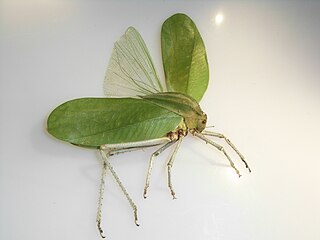
Siliquofera is a genus of bush cricket in the subfamily Phyllophorinae that includes only one species, Siliquofera grandis, which is fairly common and widespread in rainforest canopies of New Guinea and nearby smaller islands, and seemingly rare in Australia where only found in the remote Iron Range region. This very well-camouflaged, green and leaf-like bush cricket is one of the world's largest Orthoptera, with adults typically having a length of 10.7–13 cm (4.2–5.1 in) and a wingspan of 25–27 cm (9.8–10.6 in); it can weigh more than 30 g (1.1 oz).

Josef Redtenbacher was an Austrian entomologist and teacher. He specialized in the orders of Orthoptera, Phasmatodea, Mantodea (mantis) and Blattodea (cockroaches), which are classically summarized as Orthoptera, as well as in the earwigs (Dermaptera), which are not assigned to the Orthoptera, especially from Austria-Hungary and Germany.
















